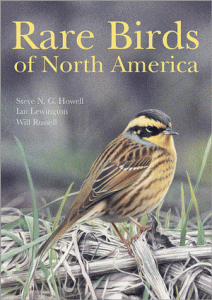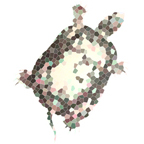Posts Tagged Rare Birds of North America
Book Review: Rare Birds of North America
Posted by Matthew Bettelheim in Book Reviews, Field Guide, Natural History, Ornithology on June 3, 2014
 Rare Birds of North America, by Steve N. G. Howell, Ian Lewington, and Will Russell, Princeton University Press (http://press.princeton.edu), 2014, 448 pages, $35.00
Rare Birds of North America, by Steve N. G. Howell, Ian Lewington, and Will Russell, Princeton University Press (http://press.princeton.edu), 2014, 448 pages, $35.00
Though I’m a rank and file wildlife biologist, I consider myself more a birdwatcher than a birder. So it was with some surprise when I cracked open Rare Birds of North America to find that this new guide to rare North American birds dealt not in threatened or endangered species, but in vagrant species – those that turn up in scarce numbers (averaging 5 or fewer) at locations atypical of their natural range during migration events. Knowing this is key to appreciating the scope of this guide, which looks at some 262 straggler species who – whether by misorientation or weather or bad directions – run the risk of waking up one morning to find a gaggle of bino-eyed birders ogling them to check another vagrant off their life list.
Vagrancy is a curious thing in birds, a phenomenon poorly understood even today. But as authors Howell, Lewington, and Russell so carefully explain in the introduction, there are no shortage of explanations for how migratory birds stray off course. Birds are their own pilots with an array of navigational tools at their disposal, be it reading the landscape by sight, following celestial features (stars, sun, moon), or following the Earth’s magnetic field. But like pilots, their tools can be hampered by inclement weather or poor data, causing birds to turn back from exhaustion or give in to prevailing headwinds. Similarly, whether their migratory patterns are learned or innate, a miscalculation of time, distance, or environmental cues (barometric pressure, wind direction) can lead birds to over- or undershoot their destinations. Every species is different, but certain vagrants in North America are more common than others (East Asian species typically occur in western North America, Western Eurasian species typically occur in eastern North America), and shrewd birders keen on bird migration and weather systems can predict vagrants with surprising accuracy (see, for example, Derek Lovitch’s How to be a Better Birder).
Once the basis and reasoning for vagrant birds occurring in North America is established, Rare Birds… spills into a field guide to said rarities. Not a guide you’d necessarily lug around in your pants pocket – odds are if you’re chasing vagrants through the woods, you’ve got your eyes glued to your binoculars, not your bird guide – but surely one you’d consult as you planned your trip, on the plane as you share airspace with fellow migrants, or in the passenger seat as you hurtle towards your destination. The species accounts are quick and clean, with an emphasis on a description of their distribution and status (essentially, where they should be, and where vagrants have turned up) backed by a discussion of vagrancy patterns and field identification. Ian Lewington’s illustrations are exceptional, inside and out. The cover illustration of a Siberian accentor looks like a gritty, bokeh-styled field photograph I would be proud to have taken. So if you take your birds rare, don’t miss out on this impressive testament to the study of vagrancy in North American birds.

